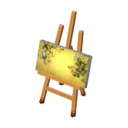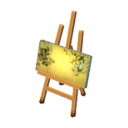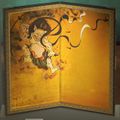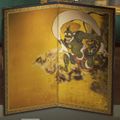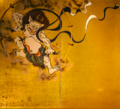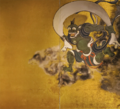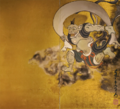Wild painting
| ||||||
 The wild painting in Animal Crossing: New Leaf | ||||||
| Real-world counterpart | ||||||
|---|---|---|---|---|---|---|
| Folding Screen Of Fūjin And Raijin | ||||||
| Year | Unknown | |||||
| Artist | Tawaraya Sōtatsu | |||||
| Main appearances | ||||||
|
| ||||||
Name in other languages
あらぶるめいが
粗野的名画 Toile sauvage Cuadro naturaleza Quadro intenso Дикая картина
혼란스러운 명화 粗野的名畫 Toile sauvage Cuadro naturaleza Ungestümgemälde Onstuimig schilderij | ||||||
The wild painting is a painting in the Animal Crossing series introduced in Animal Crossing: New Leaf. It is based on Tawaraya Sōtatsu's Folding Screen of Fujin and Raijin.
Art details[edit]
In New Leaf[edit]
| Museum description | Fūjin, the wind god, is holding a bag that causes wind, while Raijin, the thunder god, uses taiko drums. |
|---|---|
| Buy price | |
| Sell price | |
| Obtain from | |
| Authenticity | In the forgery, Fūjin and Raijin are mirrored horizontally. If Fūjin is on the right and Raijin on the left, it is genuine. |
| Furniture size |
In New Horizons[edit]
As with all artwork in Animal Crossing: New Horizons, the wild painting was added in the 1.2.0 April Free Update. They were split into two halves, each of which are sold separately at Jolly Redd's Treasure Trawler. Despite being labeled a painting in-game, both halves are treated as statues in the game's code, and consequently can occasionally be sent to the player in the mail by cranky villagers (who, like lazy, jock, and smug villagers, can mail the player art, but will only send statues).
Left half[edit]
| Museum description | This folding screen shows dynamic brushwork of Fūjin and Raijin on a gold-leaf background. It is thought to be the masterpiece of Tawaraya Sōtatsu, an early-Edo- period artist. The simplification of the subjects is a style that was carried on by Ogata Kōrin. It's a style still in use today in the Rinpa school of Japanese painting. |
|---|---|
| Buy price | |
| Sell price | |
| Obtain from | |
| Authenticity | In the forgery, Raijin is green rather than white. If Raijin is colored white, it is genuine. |
| Furniture size |
Right half[edit]
| Museum description | This folding screen shows dynamic brushwork of Fūjin and Raijin on a gold-leaf background. It is thought to be the masterpiece of Tawaraya Sōtatsu, an early-Edo- period artist. The simplification of the subjects is a style that was carried on by Ogata Kōrin. It's a style still in use today in the Rinpa school of Japanese painting. |
|---|---|
| Buy price | |
| Sell price | |
| Obtain from | |
| Authenticity | In the forgery, Fūjin is white rather than green. If Fūjin is colored green, it is genuine. |
| Furniture size |
Gallery[edit]
Screenshots[edit]
The genuine wild painting left half in New Horizons
Textures[edit]
The fake wild painting in New Leaf
Icons[edit]
Wild painting
(Animal Crossing: Happy Home Designer)
Real-world information[edit]
Folding Screen of Fujin and Raijin, also known as Fūjin-raijin-zu, depicts Fūjin, the Shinto god of the wind (pictured right), and Raijin, the Shinto god of the lightning, thunder and storms (pictured left), in a diptych style painting in four divisions. It makes use of Ma, a Japanese concept of spacing and intervals.
| Art | ||||||||||||||||||||||||
|---|---|---|---|---|---|---|---|---|---|---|---|---|---|---|---|---|---|---|---|---|---|---|---|---|
| ||||||||||||||||||||||||
